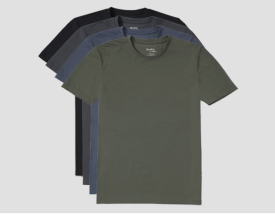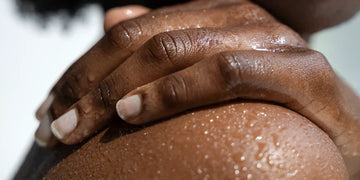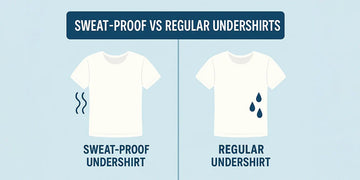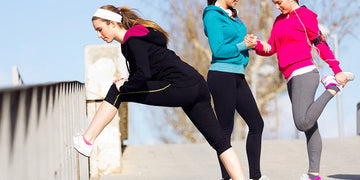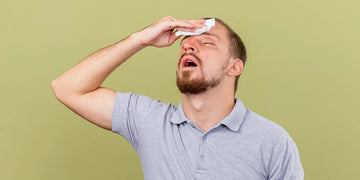We all sweat. After a tough workout, during a big meeting, or when it’s 100 degrees and your AC isn't keeping up, it’s fair enough. But what if you’re just sitting on the couch, doing nothing, and suddenly you’re drenched like you ran a marathon in your sleep? That’s not just annoying. It could be your body trying to tell you something.
This kind of unexpected, heavy sweating has a medical name: diaphoresis. And while sweating on its own isn’t usually a big deal, diaphoresis can sometimes point to a bigger health issue going on under the surface.
So let’s break it down in the most human, no-jargon way possible.
Wait, Isn’t Sweat Normal?
Totally is. Sweat as your body’s built-in AC system.
It kicks in when:
● You’re overheating
● You’re nervous or stressed (hello, first dates and public speaking)
● You’ve eaten something spicy
● Your hormones are doing a cha-cha (looking at you, menopause)
Your brain’s thermostat, called the hypothalamus, sends a signal to your sweat glands, mainly the eccrine (all over) and apocrine (armpits, groin) ones, to start the cool-down process.
But when that sweating goes zero to 100 without heat, stress, or exertion? That’s when we step into diaphoresis territory.
What Exactly Is Diaphoresis?
Diaphoresis means sudden, excessive sweating, often everywhere, even when you’re not hot, nervous, or working out. We're talking clothes-soaked, sheet-drenching, “Did I just walk through a car wash?” level sweat.
It falls under the umbrella of secondary hyperhidrosis, or sweating caused by something else. Different from primary hyperhidrosis, which is usually localized (think sweaty palms or pits) and hereditary.
So what’s causing this sweat storm? Let’s dive into the sweaty suspects.
Common Causes of Diaphoresis
Let’s break down what could be behind all that unexpected sweating. Sometimes it’s your hormones acting up. Sometimes it’s your body trying to signal that something deeper is going on. Either way, here are the usual suspects.
Hormonal Hijinks
Hormones have a way of turning your internal thermostat upside down. During menopause or perimenopause, sudden shifts in estrogen levels can confuse your body’s temperature control, leading to hot flashes and night sweats that seem to come out of nowhere. Pregnancy also turns up the heat, literally. With your metabolism running faster and hormones constantly shifting, sweating more is just part of the package.
If you’re carrying extra weight, your body has to work harder to stay cool, which can lead to more sweating too. And then there’s puberty, when teens often experience increased sweating as their bodies adjust to the surge of new hormones. Whether it’s a life stage or a hormonal shift, your sweat glands are often along for the ride.
Medical Mayhem
Sometimes your body starts sweating for reasons that have nothing to do with heat or exercise. Conditions like hyperthyroidism can speed up your metabolism, raising your body temperature and triggering excessive sweat. Diabetes can cause sudden, intense sweating when blood sugar drops too low. Cold sweats paired with chest pain or shortness of breath may signal a heart attack, which needs immediate attention. Infections like tuberculosis, HIV, or a stubborn flu can lead to fevers and night sweats.
Certain cancers, especially lymphoma, are also known to cause this. Severe allergic reactions, or anaphylaxis, may bring on cold, clammy sweat along with trouble breathing. Withdrawal from alcohol or medications can disrupt your nervous system and lead to sweating episodes. Neurological disorders like Parkinson’s and some spinal injuries may also interfere with how your body controls sweat. Even rare causes like endocrine tumors, spider bites, gout, or autoimmune diseases such as lupus can send your sweat glands into overdrive.
Medication Side Effects
Some medications can sneakily crank up your sweat levels. Antidepressants like SSRIs and SNRIs may mess with your brain's temperature control. Diabetes meds such as insulin or sulfonylureas can trigger sweating when blood sugar dips. Hormonal therapies like tamoxifen and leuprolide, along with pain relievers like NSAIDs and opioids, can also throw off your body’s cooling system.
Even asthma inhalers, heartburn meds, erectile dysfunction drugs, and neurological treatments for Parkinson’s may list sweating as a side effect. If you're sweating more than usual and can't figure out why, your medication could be part of the story. It's always worth a second look.
Diaphoresis Red Flags: When Sweat Could Mean Something Serious
If you're sweating a lot and something just feels off, pay close attention to what your body is trying to say. Warning signs can include chest pain or tightness, shortness of breath, dizziness, or even fainting. You might also experience nausea, vomiting, confusion, or slurred speech. A racing or irregular heartbeat can be another clue that something’s not right.
Other red flags include night sweats that completely soak your sheets, sweating on just one side of the body, or unexplained skin rashes and irritation.
If any of these symptoms show up with the sweating, don’t ignore them. It’s time to call your doctor and get checked out. Better safe than sorry.
Getting Diagnosed: What to Expect
A doctor won’t just hand you a towel and send you on your way. They’ll take a thorough look at what’s going on, starting with a detailed medical history to understand when the sweating started, how often it happens, and what other symptoms you might be experiencing.
Next comes a full physical exam to check whether the sweating is localized or happening all over your body. From there, they may order lab tests to look at things like blood sugar levels, thyroid function, and signs of infection.
If something more serious is suspected, imaging tests such as chest X-rays or CT scans may be used to check for tumors or other internal issues.
To better understand the sweating itself, your doctor might recommend sweat-specific tests. These can include the starch-iodine test to identify where sweating is happening, a thermoregulatory sweat test to see how your body reacts to heat, or skin conductance testing to measure how well your sweat glands are working.
All of this helps your healthcare provider figure out what’s causing the excessive sweating and how to treat it effectively.
Treatment: How to Turn Down the Sweat

When it comes to managing diaphoresis, treatment usually starts by identifying the underlying cause. From there, it’s about controlling symptoms and making lifestyle changes to help you stay dry and comfortable.
Step 1: Treat the Root Cause
If an overactive thyroid is the problem, antithyroid medications can help regulate hormone levels. For blood sugar crashes, insulin or dietary changes may be necessary. If an infection is causing the issue, antibiotics or antivirals are the go-to. And in serious situations like a heart attack or allergic reaction, seek emergency care right away.
Step 2: Review Your Medications
Certain prescriptions can trigger excessive sweating. Your doctor may recommend changing medications or adjusting your current dosage. Sometimes that small change can make a big difference.
Step 3: Manage the Sweat Itself
If the sweating continues even after treating the root issue, there are direct ways to manage it. Prescription antiperspirants with aluminum chloride are effective for underarm sweating. Botox injections can block the nerve signals that activate sweat glands. Iontophoresis uses a gentle electric current to reduce sweating in the hands and feet.
For more widespread symptoms, oral medications like glycopyrrolate or oxybutynin may help. If your sweating is triggered by stress, beta-blockers can calm your body’s response. In severe cases that don’t respond to other treatments, a procedure called sympathectomy can be considered. Laser treatments and minor surgeries can also target overactive sweat glands, especially in the underarms.
Step 4: Holistic Tools
If anxiety or emotional stress is making things worse, holistic approaches can be useful. Yoga and meditation help calm the nervous system. Biofeedback training teaches you how to control certain body functions, including sweating. Cognitive behavioral therapy, or CBT, can help you manage the mental side of things and reduce the emotional triggers behind your symptoms.
Lifestyle Tweaks That Actually Help
Wearing breathable, moisture-wicking fabrics helps your body stay cool and dry. For those dealing with heavy sweating, switching to a sweat proof shirt or sweat proof undershirt can minimize visible sweat. Products like Neat Apparel shirts are specifically designed to prevent sweat from soaking through, offering a discreet solution for daily wear.
Staying well-hydrated supports your body’s natural temperature regulation. Avoiding common sweat triggers such as spicy food, caffeine, and alcohol can also help reduce sweating episodes.
Keeping your environment cool with fans or air conditioning helps prevent overheating. Maintaining a healthy weight may reduce the effort your body puts into cooling itself, which can lower sweat levels.
Daily hygiene is important for managing both sweat and odor. Using antibacterial soap, wearing moisture-wicking socks, and choosing breathable footwear all contribute to better sweat control. Armpit shields can provide an extra layer of protection by absorbing moisture and preventing stains on clothing.
These small lifestyle adjustments can make a noticeable difference in managing daily sweating.
Frequently Answered Questions
What is the difference between diaphoresis and regular sweating?
Regular sweating usually happens in response to heat, exercise, or stress. Diaphoresis, on the other hand, is excessive sweating that occurs without an obvious reason and is often linked to medical conditions, medications, or hormonal changes.
Can anxiety or stress cause diaphoresis?
Yes, emotional stress and anxiety can activate the sympathetic nervous system, leading to excessive sweating. While this is more common in areas like the palms, feet, and underarms, some people may experience full-body sweating during intense stress.
When should I be concerned about excessive sweating?
You should talk to a healthcare provider if your sweating is sudden, occurs at night, soaks through clothing or bedding, happens without clear triggers, or comes with other symptoms like chest pain, dizziness, or weight loss. These can be signs of an underlying medical issue.
Can medications cause diaphoresis?
Yes, several medications list excessive sweating as a side effect. Common culprits include antidepressants, diabetes drugs, hormonal therapies, and some pain relievers or neurological medications. If you notice new or worsening sweating after starting a medication, consult your doctor.
Are there non-medical ways to manage excessive sweating?
Absolutely. Wearing breathable, sweat proof clothing like Neat Apparel shirts, staying hydrated, avoiding spicy foods and caffeine, using antibacterial soap, and keeping your environment cool can all help reduce daily sweat. Products like sweat proof undershirts and armpit shields are also helpful for managing visible signs of sweat.
Don’t Ignore What Your Sweat Is Telling You
Diaphoresis might seem like an annoying side effect of life, but it’s often a messenger. Your body is trying to get your attention. Whether it’s a thyroid glitch, blood sugar crash, or a more serious health issue, sweat is information.
If you’re sweating for no clear reason and it’s messing with your day or night, get it checked out. The sooner you find the root cause, the sooner you can get relief.
